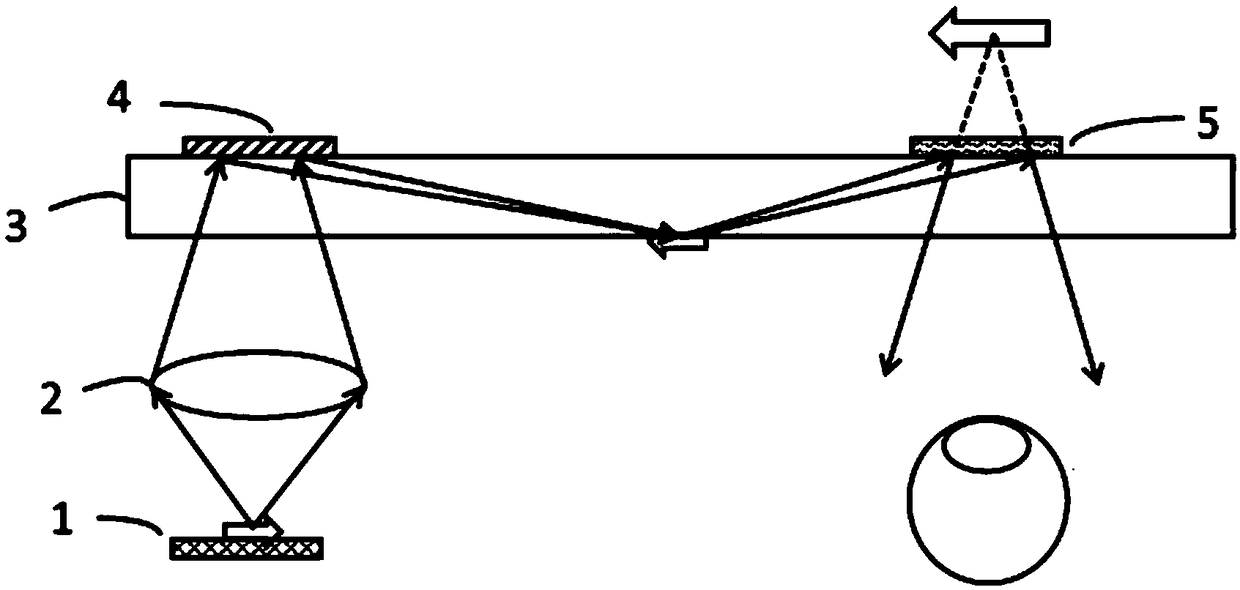Holographic waveguide displaying device
A display device, holographic waveguide technology, applied in the direction of optical components, optics, instruments, etc., can solve the problems of unsatisfactory field of view expansion effect, complex grating exposure process, high refractive index modulation degree, etc., and achieve simple and compact optical structure, preparation and processing Easy, low-cost effect
- Summary
- Abstract
- Description
- Claims
- Application Information
AI Technical Summary
Problems solved by technology
Method used
Image
Examples
Embodiment 1
[0027] Such as figure 1 As shown, the multi-angle collimated microdisplay 1 emits a light beam with image information to the lens group 2. The light beam is refracted by the lens group to reach the holographic waveguide, and first passes through the flat waveguide 3 to reach the reflective volume holographic grating 4 located in the input area of the waveguide. The light beam It is diffracted by the holographic grating 4 into the waveguide 3, propagates in the waveguide 3 in the form of total reflection, and forms an inverted real image during the propagation of the waveguide, and finally reaches the output area of the slab waveguide 3, and diffracts into the waveguide 3 through the reflective volume holographic lens 5. The human eye forms an upright enlarged virtual image in front of the human eye.
[0028] The lens group 2 is a doublet lens (objective lens), the diameter of the lens is 50 mm, the focal length is 40 mm, and the field angle is 20 degrees; the reflective vo...
Embodiment 2
[0031] Such as figure 1 As shown, the multi-angle collimated microdisplay 1 emits a light beam with image information to the collimator lens group 2, and the light beam is refracted by the collimator lens group 2 to reach the holographic waveguide, and first passes through the slab waveguide 3 to reach the reflective body located in the input area of the waveguide Holographic lens 4, the light beam is diffracted by the holographic lens 4 into the waveguide 3, propagates in the waveguide 3 in the form of total reflection, and forms an inverted real image during the waveguide propagation process, and finally reaches the output area of the slab waveguide 3. The holographic lens 5 diffracts into the human eye, forming an upright enlarged virtual image in front of the human eye.
[0032] Lens group 2 is a collimating lens group with a focal length of 30 mm; reflective volume holographic lens 4 is a doublet lens (objective lens) with a lens diameter of 50 mm, a focal length of 8...
Embodiment 3
[0035] Such as figure 2As shown, the multi-angle collimated microdisplay 1 emits a light beam with image information to the slab waveguide 3, first passes through the slab waveguide 3 and reaches the reflective volume holographic lens 4 located in the input area of the waveguide, and the light beam is diffracted by the holographic lens 4 and enters the waveguide 3 , propagating in the waveguide 3 in the form of total reflection, and form an inverted real image during the propagation process of the waveguide, and finally reach the output area of the slab waveguide 3, diffract into the human eye through the reflective volume holographic lens 5, and form a positive image in front of the human eye Standing magnified virtual image.
[0036] The reflective volume holographic lens 4 is recorded in the photopolymer, the reference light angle is 45 degrees, and the object light angle is 0 degree; the reflective volume holographic lens 4 is a lens group, the diameter of the lens gr...
PUM
| Property | Measurement | Unit |
|---|---|---|
| Thickness | aaaaa | aaaaa |
| Thickness | aaaaa | aaaaa |
| Lens diameter | aaaaa | aaaaa |
Abstract
Description
Claims
Application Information
 Login to View More
Login to View More - R&D
- Intellectual Property
- Life Sciences
- Materials
- Tech Scout
- Unparalleled Data Quality
- Higher Quality Content
- 60% Fewer Hallucinations
Browse by: Latest US Patents, China's latest patents, Technical Efficacy Thesaurus, Application Domain, Technology Topic, Popular Technical Reports.
© 2025 PatSnap. All rights reserved.Legal|Privacy policy|Modern Slavery Act Transparency Statement|Sitemap|About US| Contact US: help@patsnap.com


